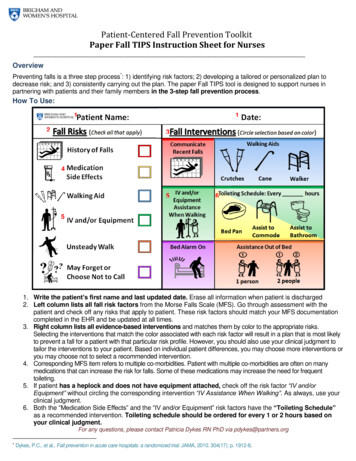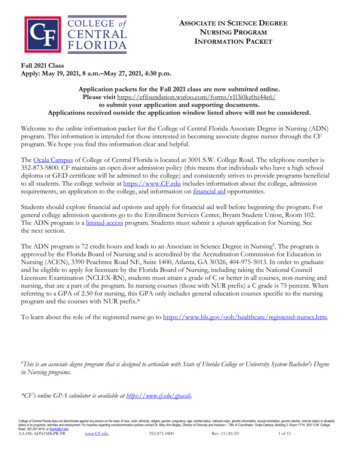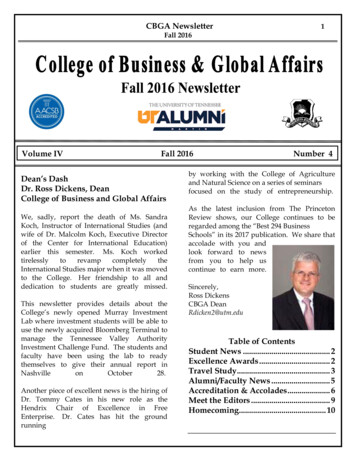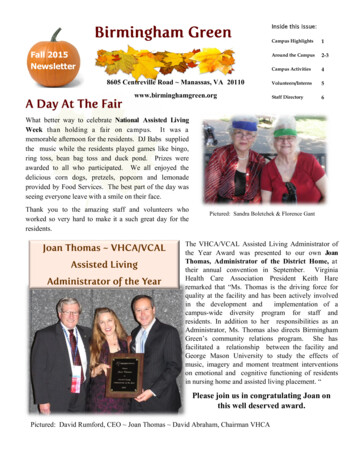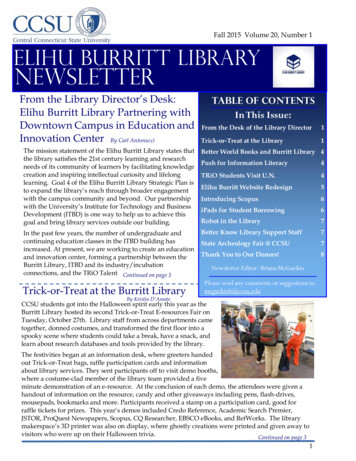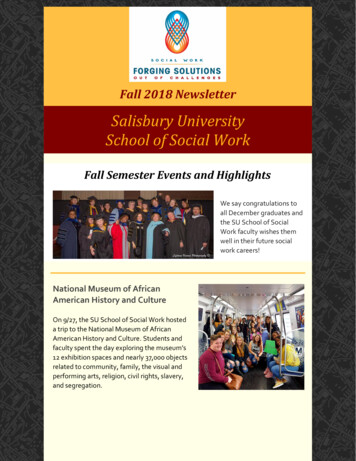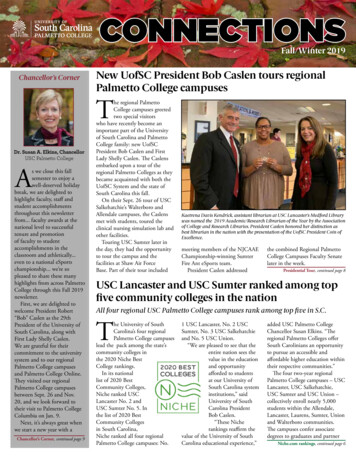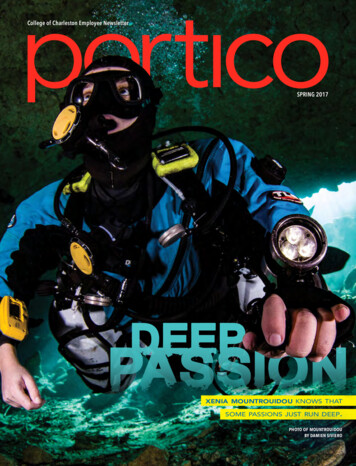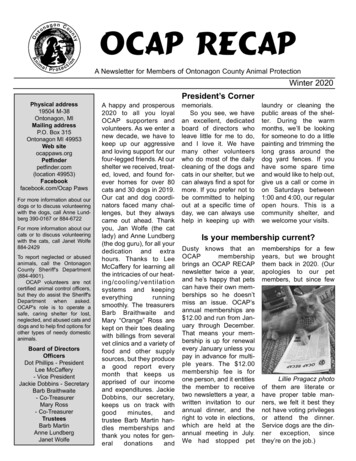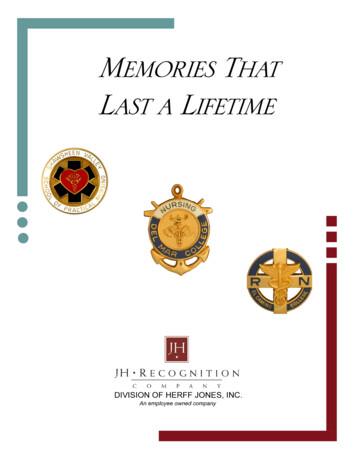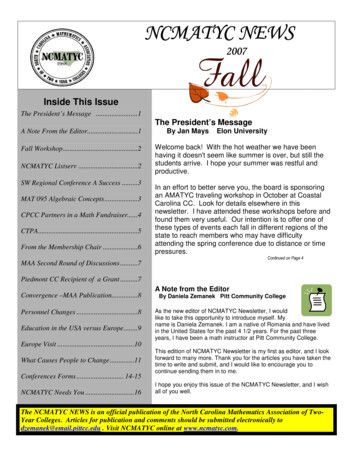
Transcription
NCMATYC NEWS2007Inside This IssueThe President’s Message .1The President’s MessageA Note From the Editor.1Fall Workshop.2NCMATYC Listserv .2SW Regional Conference A Success .3MAT 095 Algebraic Concepts.3CPCC Partners in a Math Fundraiser.4CTPA.5From the Membership Chair .6By Jan MaysElon UniversityWelcome back! With the hot weather we have beenhaving it doesn't seem like summer is over, but still thestudents arrive. I hope your summer was restful andproductive.In an effort to better serve you, the board is sponsoringan AMATYC traveling workshop in October at CoastalCarolina CC. Look for details elsewhere in thisnewsletter. I have attended these workshops before andfound them very useful. Our intention is to offer one ofthese types of events each fall in different regions of thestate to reach members who may have difficultyattending the spring conference due to distance or timepressures.Continued on Page 4MAA Second Round of Discussions .7Piedmont CC Recipient of a Grant .7Convergence –MAA Publication.8Personnel Changes .8Education in the USA versus Europe.9A Note from the EditorBy Daniela Zemanek Pitt Community CollegeAs the new editor of NCMATYC Newsletter, I wouldlike to take this opportunity to introduce myself. Myname is Daniela Zemanek. I am a native of Romania and have livedin the United States for the past 4 1/2 years. For the past threeyears, I have been a math instructor at Pitt Community College.Europe Visit .10What Causes People to Change.11Conferences Forms . 14-15NCMATYC Needs You .16This edition of NCMATYC Newsletter is my first as editor, and I lookforward to many more. Thank you for the articles you have taken thetime to write and submit, and I would like to encourage you tocontinue sending them in to me.I hope you enjoy this issue of the NCMATYC Newsletter, and I wishall of you well.The NCMATYC NEWS is an official publication of the North Carolina Mathematics Association of TwoYear Colleges. Articles for publication and comments should be submitted electronically todzemanek@email.pittcc.edu . Visit NCMATYC online at www.ncmatyc.com.
Fall WorkshopBy Deborah Benton Wake Technical Community CollegeNCMATYC is hosting an AMATYC traveling workshop on BeyondCrossroads. Join us at Coastal Carolina Community College on Octthe 19th to get to know each other and learn about Crossroads.The board hopes this will give people in the opposite end of the state a chance to get together withouttraveling too far. We will start out the day with a continental breakfast and conclude around noon.We hope you will join us.Please find the Application to Attend AMATYC Traveling Workshop on page 15.NCMATYC Listserv has a “New” ListownerBy Dr. Claude S. MooreCape Fear Community CollegeNCMATYC listserv has a “new” listowner. To allow Jan Mays more time in herposition as President of NCMATYC, I assumed the responsibilities as listserv ownerthis summer. My contact information is Dr. Claude S. Moore, MathematicsInstructor, Cape Fear CC, 411 North Front Street, Wilmington, NC 28401, (910) 362-7656,cmoore@cfcc.edu .Any member of NCMATYC and persons who share and support the mission of NCMATYC may be amember of the listserv. Once you have subscribed to the listserv, you may post a message to the listby sending an e-mail to ncmatyc@list.ncccs.cc.nc.us and your message will be distributed to allsubscribers.The listserv is for emails and usually does not accept attachments, images, special characters, longmessages, etc. If you attempt to post something that is not acceptable, your post will be “bounced”which means it will not be posted. It is recommended that you post such messages on your websiteand post the appropriate link on the listserv so that members may retrieve the message.To contact a human site manager, send an email to Majordomo-Owner@list.ncccs.cc.nc.us.To contact the owner of ncmatyc@list.ncccs.cc.nc.us, send an email toncmatyc-approval@list.ncccs.cc.nc.usTo get a copy of the help message, send mail to Majordomo@list.ncccs.cc.nc.us with a line sayinghelp in the message body.If you go to Minneapolis for the AMATYC Conference, November 1-4, 2007, please considersubmitting an article for the next edition of NCMATYC Newsletter on sessions that you attended.The deadline for the Winter 2007/2008 issue is December 6, 2007.2
SW Regional Conference A SuccessBy Rob KimballWake Tech Community CollegeIt has been a long while since the last regional AMATYC conference,so there was a lot of anxiety about an AMATYC regional conference.However, because of good planning and enthusiastic affiliates, theconference was a success. Of course being in San Antonio was aplus! The Riverwalk, the Alamo, the heat!!!The conference drew a wide variety of presenters on a number of topics. You can obtain several ofthe presenter's files from the conference website: ile in San Antonio, I attended a two-day workshop on Texas Instruments' new handheld - N-Spire . This device does a number of things, including having an Excel-like spreadsheet built in. It alsohas split-screen capabilities and you can grab and drag curves while seeing the equation change.TI is still making changes to the software.MAT 095 Algebraic Concepts - An Intermediate Algebra CourseDesigned to Prepare Students for College AlgebraBy Dr. Katalin SzucsPitt Community CollegeBrief history:East Carolina University students must have a passing placement test score (orappropriate SAT score) to take college level math courses. Those who did notscore high enough to be in college level courses will take a review (remedial)math course.The large number of students who had to take a review course created anoverwhelming problem for ECU’s Math Lab in the late 1980s.To remediate these students, while keeping them on campus and in their other courses, ECUcontracted Pitt Community College (PCC) to teach an Intermediate Algebra course.Representatives from PCC and ECU met and established a system described in the “Memorandumof Understanding” detailing the responsibilities of each institution. This includes course content,textbooks, personnel, classroom space, enrollment and withdrawal procedures, cost, etc.The students involved in this program are jointly enrolled at PCC and ECU, and the studentmembership hours for the purpose of accruing FTE’s are reported by PCC. The instructors andmaterial are provided by PCC. For the convenience of the students the classes are held on ECUcampus, and follow ECU’s calendar. The students receive two hours of credit and the grade countsin their GPA at ECU. They also receive three hours of credit and a grade at PCC. Since the programwas developed, the number of sections has increased to 30 sections per year (to about 800 students)and is expected to continue to grow.Format of the course:To accommodate the different mathematical backgrounds and learning styles of our students, weoffer two alternatives:1) Traditional sections in a classroom setting with a lecturing instructor.2) Self-paced lab sections, an individualized program with a teacher and lab assistants.The students have the option to select the course format. The course content and the book (currentlyTobey/Slater Intermediate Alg. 5th Ed. with MyMathLab) are the same for both.Continued on Page 133
CPCC Partners with Local Elementary School in a Math FundraiserBy Laura TuckerCentral Piedmont Community CollegeLast spring, Central Piedmont Community College’s Math Division partnered with Charlotte’s HickoryGrove Elementary in a fundraiser to raise funds for Hickory Grove’s math curriculum needs.On April 19th, all of the 3rd grade students took a 25 question math test. The test was written byteachers from both CPCC and Hickory Grove and covered skills the students would be tested onduring their End-of-Grade exam. CPCC sponsored the class with the highest number of correctanswers. The top class, taught by Ms. Tracy Mott, correctly answered a total of 370 of the 550problems.Math Division faculty along with other CPCC employees contributed to this worthy cause by pledgingan amount per correct answer. Thanks to everyone’s generosity, 908.65 was raised.On May 17th, four representatives from theMath Division (Janice Ervin, Cindy Fowler,Laura Tucker, and Mary Ann Bradham – seephoto) presented Hickory Grove’s principal,Michael Alcala, and Ms. Mott’s class with acheck while everyone enjoyed ice creamsundaes in celebration of this wonderfulaccomplishment.The President’s MessageContinued from Page 1NCMATYC would also like to increase involvement of developmental math instructors across thestate. Because some schools have developmental departments that are separate from the mathdepartment, communication can be difficult. I encourage you to share information about NCMATYCwith developmental colleagues at your school.This is an election year for NCMATYC. Watch for a ballot to arrive sometime this fall and please taketime to vote for the leadership of your choice. This is your organization and we value your input in thedirection you wish NCMATYC to take.Mark your calendar for our annual spring conference, March 13 and 14, 2008 at Forsyth TechnicalCC in Winston-Salem. Our keynote speaker for the conference will be Marty Triola. Please notethere is a presenter's form included in this newsletter and consider sharing your expertise bypresenting a session or workshop in the spring.Also remember the AMATYC conference will be in Minneapolis November 1 - 4, 2007. Thisconference is a wonderful opportunity to make connections with math instructors across the countryand bring new ideas back to our classrooms.I hope all of you have a successful and rewarding 2007-08 school year.4
College Transfer Program Association CTPABy Lee Ann SpahrDurham Technical Community CollegeThe College Transfer Program Association ( CTPA) is a relatively new and rapidly growing statewideorganization dedicated to keeping its members informed regarding transferability issues, legislativechanges, student and institutional transfer data, and changes in higher education that potentiallyimpact our students. Through membership in CTPA, we all have an opportunity to give input andhelp shape our curriculum.In its September 2006 meeting, the CTPA made the following statement:MAT 171 and 172 (both must be taken) or MAT 175 are now the beginning-level math classes atUNC-CH and NC State. Additionally, statistics courses (MAT 151 or 155) are not considered mathcredits at either UNC-CH or NC State. In response to changing math requirements at the universitylevel, the CTPA recommends a reexamination of the math courses in the articulation agreement,including CIS 110 as a general education math credit.As a result of this discussion, a Mathematics Study Committee was formed, consisting of threestatewide mathematics faculty and one college vice-president. The recommendation from the studycommittee was: The committee does not believe that MAT 140 and CIS 110, combined as the two required Gen. Ed.maths, gives students a strong math background for transfer.CIS 110 is used by some schools as verification that students have a computer competency. Others useit as prerequisite for on-line classes. Others verify that prerequisite with a CIS placement test.The dual existence of MAT 161 and MAT 171 was discussed (again), and while the two can beconfusing, math instructors believe the distinction between them in focus and depth of content warrantscontinuation of separate courses.Determining the best math courses for transfer is complicated not only by requirements of differentmajors but also by the varying requirements in Gen. Ed. math among the UNC-System universities.Recommendations to be brought to the Spring Meeting for discussion or voteo Recommend that AA degrees be changed to offer as the primary math MAT 151, 161, 171 orhighero Recommend that all other MAT core courses, including MAT 140, CIS 110 and CIS 115, berelegated to the second Gen. Ed. math category. With this change, a student will not be able tocombine MAT 140 and CIS 110 to meet Gen. Ed. MAT requirements.The Spring Meeting of the CTPA was held at Wake Technical Community College April 20, 2007, withmore than 200 attendees, including members of the Transfer Advisory Committee, representativesfrom the System Office, and numerous faculty and administrators from colleges across the state. Iam happy to report that we had 14 active NCMATYC members present, and we all sat together as agroup and presented a unified voice. After much discussion among the attendees regardingmathematics transfer courses, the following recommendations were subsequently distributed to theCTPA membership for a vote.Recommendation 7: The CTPA recommends that one of the two required math courses for the AA degree beMAT 151, 161, 171, or higher. With this change, a student will not be able to combine MAT 140 and CIS 110 tomeet Gen. Ed. MAT requirements.Justification: The committee does not believe that the combination of MAT 140 and CIS 110, combined as thetwo required Gen. Ed. maths, gives students an adequate math background for transfer.Continued on Page 65
College Transfer Program AssociationContinued from Page 5Recommendation 8: The CTPA recommends that CIS 110, Introduction to Computers, be eliminated as aquantitative core option for satisfying the second math requirement in the AA degree. CIS 110 would bereclassified as pre-major/ elective. New line would read:"This course has been approved to satisfy the Comprehensive Articulation Agreement for transferability as apre-major and/or elective c
By Daniela Zemanek Pitt Community College As the new editor of NCMATYC Newsletter, I would like to take this opportunity to introduce myself. My name is Daniela Zemanek. I am a native of Romania and have lived in the United States for the past 4 1/2 years. For the past three years, I have been a math instructor at Pitt Community College. This edition of NCMATYC Newsletter is my first as editor .

